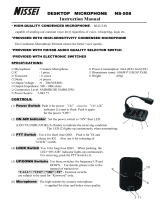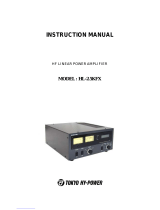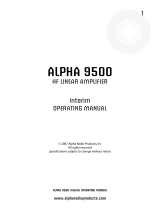Page is loading ...

Important safety instructions:
• The amplifier contains high voltage circuits. Never turn the amplifier on
without the upper lid in place.
• The OM3500A amplifier is neither to be used in a wet or humid environment
nor to be exposed to rainfall.
• The amplifier must be installed in such a way that free flow of hot air from
the tube is allowed. The amplifier must not be installed in a constrained
surrounding (i.e. tight shelves etc.)
• During long operation the upper lid and the vent grid of the amplifier can
reach high temperatures that can cause burn injuries. Do not touch these parts
of the amplifier during operation.
• The amplifier must be grounded during operation.
• During operation the amplifier must be installed in such a way that the rear
power supplies are accessible.
• The amplifier can be operated only if both supply cables are connected.
OM3500A reaches optimal parameters when it is connected to 2 phases.
• Do not turn the amplifier on without having connected the antenna.
A hazardous HF voltage may build up on the antenna connector after turning
the amplifier on with no antenna connected.
• Before opening the upper lid of the amplifier make sure that both power
supplies have been disconnected for at least 5 minutes allowing the
electrolytic capacitors to discharge fully. Never turn the amplifier on without
the upper lid in place.
• Make sure that all screws holding the case together are properly in place and
tied before carrying the amplifier by the handles.
• The amplifier is an A category product. In a household it can influence other
electric appliances. In such cases the user is to take proper actions to mitigate
this disturbance.

General description of the OM3500A Amplifier
The linear amplifier OM 3500A is designed for all short wave amateur bands from 1.8 till 29
MHz (including WARC – bands ) and all modes . It is equipped with a ceramic tetrode
GU78b. The OM3500A is automatically tuned to operating frequency of your TRX.
Specification of OM3500A
Frequency coverage: amateur bands 1.8 – 29.7 MHz including WARC
Power output: 3500 W in SSB and CW 3000 W in RTTY, AM and FM
Drive Power: usually 60 to 80 W for full Output Power
Input impedance: 50 Ohm VSWR < 1.5 : 1
Output amplification: 17 dB
Output impedance: 50 Ohm unbalanced
Maximum output SWR: 2:1
SWR protection: automatic switching to STBY , when reflected power is 350W or higher
Intermodulation distortion : 32 dB below nominal output
Suppression of harmonics: < -50 dBc
Tuning manual or AUTO
Response speed of AUTO less than 0,5s within same BAND
Less than 3s if out of BAND
Supported TRXs-CAT ICOM, ELECRAFT ,KENWOOD, TEN-TEC ORION , YEASU
and Icom transceive protocol using by microHAM devices – CI-V
OUPUT
Tube: GU78b Ceramic tetrode
Cooler: Centrifugal blower + axial blower
Power supply: 2 x 230 V - 50 Hz one or two phases
Transformers: 2 pcs of toroidal transformer 2,5 kVA
Protection circuits: - SWR too high
- Anode current too high
- screen current too high
- grid current too high
- Mistuning of power amplifier
- Hot switching protection
- Soft start for protecting your fuses
- “switch –on blocking “ at opened amplifier
Bar graph indications: - Power output – bar graph 50 LED
- reflected power – bar graph 20 LED
- screen current ( Ig2 – bar graph 10 LED )
- anode voltage, anode current, tuning – bar graph 30 LED
LED indicators : grid current ( Igl – 2 LED )
WAIT – preheating of tube (180 sec )
STBY - standby
OPR – operating condition
FAULT – failure , switching off for abt. 2 sec
OSD Indication LCD display 2x16 Characters
Parameters: 485 x 200 x 455mm (width x height x depth)
Weight: 43 kg

General Description of OM3500 A POWER AMPLIFIER
HF PART
In this amplifier a tetrode GU 78b is used in a grounded-cathode circuit (input into control grid). This
amplifier achieves excellent linearity by the voltage stabilization of the control grid bias and the screen
voltage. The power input is given to the control grid, using a broadband input circuit with an input
impedance of 50 Ohms. This adaptable input circuitry ensures a good input SWR better than 1.5:1 on
all short-wave bands.
The output of the amplifier is a Pi-L circuit. The ceramic capacitor for TUNE and LOAD are divided.
This enables the amplifier to be tuned exactly and makes it possible to easily return to the previously
set positions after band change.
Top view on the opened OM3500A
Tetrode
GU78B PWR meter Blower switch -on board
Output Pi-L Circuit Tuning capacitor Power supply board
Subpanel

POWER SUPPLY
Power supply of the amplifier is effected by two 2,5 kVA toroidal transformers. A soft start is
realized with the help of relays and resistors.
The high anode voltage consists of 8 times 420V and 2A. Each of them has its own rectifier and filter.
In the high voltage circuit safety resistors are employed to protect the amplifier against overload.
The source for screen grid is stabilized by a parallel stabilization with BU508 transistors and delivers
a voltage of 360V at 100mA.
The -120V for the control grid is stabilized by means of zener diodes.
SAFETY DEVICES
Control and monitoring circuits ensure control and safety of the circuits of the device during
malfunction of the PA. They are placed on the Control board, which is located on the subpanel.
Putting the power amplifier into operation
Coaxial cable
The output of the transceiver is to be connected with the input of the amplifier via RG58 or similar
cable. For the connection between the power amplifier and the antenna RG213 or similar coaxial
cable suited for this high power is to be used. For INPUT and OUTPUT PL-259-sockets with Teflon
isolation are used.
Mains plug1 Mains plug2 Fuses OUTPUT
REMOTE I / O Interface INPUT
Rear view of the amplifier

MAIN SUPPLY:
The amplifier is connected to the mains with 2 cables with a EURO end. Each cable is to be
switched to another phase of your main supply system! Both of them have to be able to deliver a
power of 2.5 kVA !
If you use only one phase, you have to connect both cables to this one phase ! Your main supply
has to be able to deliver 5 kVA on this one phase! In this case the power amplifier can’t deliver
full output!
ATTENTION:
In each case the power amplifier has to be connected
to your main supply system with 2 cables! Normally
the amplifier is used with 2 phases. If there is only
one phase - connect both cables to the single one!
Grounding
The amplifier has to be grounded properly! Connect the screw on the rear panel of the amplifier to
your local grounding system with a copper-cable, use a cross-section of 4 mm
2
at least.
Connect your transceiver to the same grounding system of your shack carefully!
If you use a power amplifier with higher output you have to be aware that your grounding system
works properly. All parts have to be grounded to the same system. Use short cables and make sure
that there are good contacts! Otherwise you run the risk of damaging your equipment, having
problems with TVI/BCI or your signal may be distorted.

REMOTE
Control of the amplifier is possible remotely by using REMOTE BOX (optional). Connection
is done by REMOTE socket, maximum cable length of 10 meters.
I / O box
.
Control of Amplifier and communication with TRX as well as antennas / BPF switching can
be done via I / O Interface
KEY IN - Input signal PTT (switching voltage / current 5V / 2mA)
KEY OUT - Output signal PTT (maximum switching of 30V / 50mA)
Control cable
Control cable maintains TX / RX switching of the PA (TX GND). The cable is shielded. On the side
of the power amplifier a CINCH-socket is used. On the side of your transceiver you have to use a
socket suitable for this transceiver. During transmitting the middle pin is connected to the ground.
The relays of the OM3500A have to be switched earlier than HF is applied (cold switching).
Modern transceivers have a time delay between PTT switching and power output.
If you are using and older transceiver or transmitters without time delay we recommend to connect the
PA in such a way that the transmit/ receive switch is connected with the KEY IN socket of the
amplifier. The KEY OUT socket is to be connected with the PTT socket at the transceiver.
The amplifier is equipped with two safety devices, which ensure that the Output relay is not switched
under power mistakenly (hot switching).

CI-V - Mono 3.5mm Jack for connection of ICOM TRXs. For successful
operation selection of ICOM radio and correct baud rate is important
(9600 default)
TCVR - DB-9 -serial port RS232 for YAESU, KENWOOD, ORION and
ELECRAFT TRXs. Correct baud rate and TRX type is a must for
successful operation. If both CI-V and TCVR cables are used then CI-V
wins over RS232. Otherwise selection of interface is done via TRX
type.
PC - DB9 RS232 port is used for communication of your TRX with PC.
Please use setting you would normally use as if using direct TRX – PC
connection.
ALC - RCA-Phono – Automatic Level Control is used when tuning the PA
to block drive level . We recommend to use this feature mainly while
operating RTTY, FM and other 100% duty cycles modes.
CONTROL - DB15 connector for use of single cable between PA and TRX
PIN OUT:
1. ALC Out
2. NC
3. INHIBIT Control voltage
4. TX INHIBIT for Yaesu and Elecraft – this supersedes
ALC output
5. NC
6. KEY OUT
7. NC
8. KEY IN
9. –
15. GND

ANT & BPF SW - r DB-25 is used for switching of external HP BPF or external Antenna
Switch. Maximum switching of 30V / 0.5A is possible.
PIN OUT:
1. antenna port 1
2. antenna port 2
3. antenna port 3
4. antenna port 4
5. antenna port 5
6. antenna port 6
7. antenna port 7
8. antenna port 8
9. antenna port 9
10. antenna port 10
11. COMMON port of ANT SW
12. NC
13. GND
14. BPF 160m
15. BPF 80m
16. BPF 40m
17. BPF 30m
18. BPF 20m
19. BPF 17m
20. BPF 15m
21. BPF 12m
22. BPF 10m
23. COMMON BPF port
24. NC
25. GND
Cooling
The centrifugal blowers provide the necessary cooling of the amplifier, even during long contests. The
main blower is activated by switching the PA on and it is turned off when after-cooling is finished
(approx. 1-5 min after switching off the PA depending on the temperature of the tube). The
supplemental fan is turned on depending on the temperature of the air exiting from the amplifier. It is
switched on at 70°C and switched off at 60°C.

Operation
Operating elements (see photo)
TUNE -
Anode capacitor for tuning, tuning of higher frequencies to "0",
Lower frequencies to „100“.
LOAD
- Output capacitor tunes antenna load resistance to amplifier.
Capacity is low at „100“ and high at "0" on the scale.
OFF -
You switch off the amplifier by pressing this button.
ON -
You switch on the amplifier by pressing this button.
Heating of tube is on and after 3min of delay the amplifier will be
ready for operation.
OPR/STBY -
„OPERATE“ puts unit ready for operation.
At STBY, if WAIT-LED is on or the amplifier is off your transceiver is in
bypass-mode directly connected to antenna. Maximum 400 Watts!
RF OUTPUT -
Bar graph – shows output power .
REFLECTED POWER
- Bar graph – shows reflected power of the antenna. 350W
maximum or amplifier switches to STANDBY-mode
Ig2 bar graph – measures the currency of the second grid in the range from -20mA to
+80mA
HV/IP/TUNE bar graph – measure the anode voltage, anode currency or tuning of the amplifier

INHIBIT – indicates interruption of operation during the tuning process of the PA. If
indicated by RED LED then PA is in STBY mode. If retuning within same
BAND then PA will retune according to QRG of TRX. When changing the
BAND – INHIBIT will stay lid till KEY IN is triggered for even short period
and tuning process will start. After that PA is automatically ready for
operation.
ANT, ANT1, ANT2 –PA is capable of automatic antenna switching (ie. 80m
CW and 80m SSB can be split between two antennas. PA will automatically
select desired antennas by selecting last used antenna on given frequency.
SET - button for:
- MAIN MENU
- Confirmation of selection
- Saving of selected value
- Saving of tuning parameters
TUNE - selection of TUNE mode
AUTO - selection of Automatic mode
MAN - selection of manual mode
DWN / UP - selection of band, segment or parameter

Configuring and Operating the OM3500A Power Amplifier
When the button ON is pressed, amplifier will start and will heat the ceramic tube. While this
is being done, PA will have STBY and WAIT LED lid on. If there is TRX connected to the
correct port and all communication settings are right correct operating frequency and AUTO
with type of transceiver will be indicated on the alphanumeric display. After successful
heating of the TUBE (3 mins) you can enter operating mode by pressing the OPR button..
Example of AUTO mode using ICOM TRX
Example of AUTO mode using Kenwood TRX
For communication with TCVRs
, that are not supported by OM3500A as for example
JST-245 and older types of Kenwood an external IF-232 converter is to be used. You can use
universal products of microHAM https://www.microham.com as MKII, MK2R+ etc., which
process information about the frequency in ICOM format through the CI-V output. Then the
PA will be connected in the following configuration:
JST-245<>= DB37- JST-245 cable <> MKII ( or other device from microHAM , which has
a CI-V output ) <> PC , OM3500A is connected to the CI-V output of a microHAM device.
Example of communication

If TRX is not connected or communication settings are incorrect the message
COMMUNICATION LOST will be displayed. You can still use PA by entering MANUAL
mode (MAN Button) or by fixing the communication problems
Example of Communication loss message
TRX support settings
Press SET button and scroll using UP / DWN to CHOOSE TCVR

Confirm CHOOSE TCVR by pressing SET again and scroll UP / DWN to desired TRX Type.
Confirm the selection by pressing SET
Continue by selecting Baud Rate
Below – Baud rate for TRX – PA communication displayed by OSD
By scrolling UP / DWN select desired Baud Rate which must be same as baud rate used by
connected TRX.( please refer to your TRX user guide)To confirm your selection press SET.
When using Yaesu TRX you need to configure STOP BITs parameter and confirm selection
with SET.
Communication settings menu can be left by pressing AUTO by pressing the AUTO button
PA will enter AUTO mode but only if all settings are correct and connection has been
established. You can check if correct frequency and TRX type has been displayed on OSD

Antenna Switching Menu
If you have 3
rd
party external antenna switch connected to PA ( i.e. Microham TEN SWITCH)
you need to configure assignment of each port to specific band/antenna.
By pressing SET and scrolling to ANTENNA SETTINGS and confirming by SET you get
current band and its antenna selection. By scrolling UP / DWN you can select BAND which
you want to assign to current ANTENNA selected.
Then we select how many antennas we want per current band (1 or 2) always confirm your
selection by pressing SET. The by scrolling UP / DWN you assign which PORT is used on
your external antennas switch for this particular antennas. (ANT 1 ON PORT 01)
Shall you decide to use 2 antennas for this band then after confirming that with SET
configuration continues to other antenna selection / port selection.
To finish Antennas switch configuration you can either press AUTO or MAN
/












